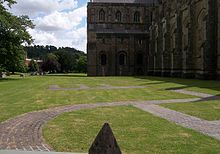- Old Minster, Winchester
-
The Old Minster was the Anglo-Saxon cathedral for the diocese of Wessex and then Winchester from 660 to 1093. It stood on a site immediately north of and partially beneath its successor, Winchester Cathedral.
The old legend that the Old Minster was built in the 2nd century for the non-existent King Lucius of Britain is erroneous. The stone minster was constructed in 648 for King Cenwalh of Wessex and Saint Birinus. It became the diocesan cathedral in 660. It was enlarged and redecorated over the years and Saint Swithun was buried outside it in 862. In 901, the New Minster was built next to it, so close in fact that it is said the singing of the monks inside each became hopelessly intermingled. Saint Æthelwold of Winchester followed by his successor, Saint Alphege, almost completely rebuilt the minster on a vast scale during their monastic reforms of the 970s. Saint Swithun's body was taken into an indoor shrine in what had become the largest church in Europe. However, after the Norman conquest of England, Bishop Walkelin built a replacement cathedral alongside and the Old Minster was demolished in 1093. Many of the Kings of Wessex and England, as well as holy saints, had been buried there, so their bodies were exhumed and re-interred in the new building.
The Old Minster was excavated in the 1960s. It is now laid out in brickwork in the churchyard adjoining Winchester Cathedral. Saint Swithun's first grave is clearly marked. Finds from the site may be seen in the Winchester City Museum. The bones of the monarchs removed to the cathedral are now housed in the famous mortuary chests around the choir.
Notable events
- Signing of the Regularis Concordia by King Edgar the Peaceable (973)
- Coronation of Edward the Confessor (1043)
- Marriage of Edward the Confessor and Edith (1045)
- Coronation of Matilda of Flanders as queen consort (1068)
Coordinates: 51°03′40″N 1°18′50″W / 51.061°N 1.314°W
This article about a Hampshire building or structure is a stub. You can help Wikipedia by expanding it.

